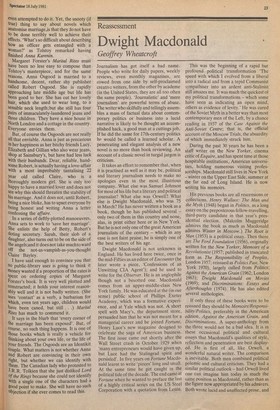. . .Or worse
A. N. Wilson
Marital Rites Margaret Forster (Seeker & Warburg pp.183, £6.95) Anna Osgood, the heroine of Margaret Forster's charming new novel, 'liked marriage . . . Being married was the most important thing in the world to her'.
We think more about marriage, one suspects, than any previous generation in history. That is why there is so much divorce: just as nobody knew quite how ill they felt until some wiseacre dreamed up the idea of being 'fie — to be tested by rigorous runs, hellish dietary programmes and endless contemplation of bodily sensations. 'I never realised that I'd let myself get so out of trim', people gasp, after sessions in the gymnasium which, one suspects, Nature never intended us to have. Fit for what?
So the question of whether marriages are a 'success' or a 'failure' is a purely modern one. But if it is an artificial question, that does not stop it being beguiling; and that is why reading fiction about married life is so enjoyable. It provides us with the satisfying illusion (which gossip never quite can) that we know exactly what other people are like and why they behave in the odd way that they do. In real life, of course, nothing is more impenetrable than marriage: its secret language of gesture, tone of voice and unspoken, shared memory, shuts out even the closest friends of the parties concerned. That is where the novelists can come blundering in. The greatest of them, such as Flaubert or Tolstoy, have anatomised marriage with such devastating skill that one sometimes forgets how rarely it has been done well. Most great novelists have not even attempted to do it. Yet, the snooty (if true) thing to say about novels which anatomise marriage,is that they do not have to be done terribly well to achieve their effects. 'What's so difficult about describing how an officer gets entangled with a woman?' as Tolstoy remarked having finished Anna Karenin.
Margaret Forster's Marital Rites must have been no less easy to compose than Tolstoy's masterpiece, and for the same reasons. Anna Osgood is married to a handsome, decent, rather shy publisher called Robert Osgood. She is rapidly approaching late middle age but life has been good to her. She has cut her lovely hair, which she used to wear long, to a sensible neck length; but she still has four Pairs of immaculately-laundered jeans and three children. They have a nice house in North London and a cottage in the country. Everyone envies them.
But, of course the Osgoods are not really all that enviable. Anna is just as precarious in her happiness as her bitchy friends Lucy, Elizabeth and Gillian who also wear jeans, Shop at Sainsbury's, but have had less luck With their husbands. Dear, reliable, handsome Robert, is actually having a love-affair With a most improbably tantalising 22 Year old called Claire, who is a thoroughly modern girl. She is only too happy to have a married lover and does not see why this should threaten the stability of his marriage. And it does not, until Robert, being a nice bloke, has to upset everyone by being honest and writing Anna a letter confessing the affaire.
In a series of deftly-plotted manoeuvres, Anna sets to work to 'save her marriage'. She enlists the help of Betty, Robert's doting secretary. Sarah, their slob of a daughter, also turns out to be on the side of the angels;and it does not take muchto ward off the not-as-vampish-as-you-thought Claire Bayley.
I have said enough to convince you that no public-library user is going to think it Money wasted if a proportion of the rates is Spent on ordering copies of Margaret Forster's book. It is very well plotted and constructed; it holds your interest reasonably well and it is not badly written. (She uses 'contact' as a verb, a barbarism for Which, even ten years ago, children would have been caned, but still . . .) Marital Rites has much to commend it.
It says in the blurb that 'every corner of the marriage has been exposed'. But, of course, no such thing happens. It is one of those books which is really a vehicle for thinking about your own life, or the life of Your friends. The Osgoods are an Identikit Couple. What matters is not whether Anna and Robert are convincing in their own right, but whether we can identify with them. The Canadian lady who protested to Tolkien that she just disliked Lord of the Rings because she could not identify With a single one of the characters had a good point to make. She will have no such Objection if she ever comes to read this.



































 Previous page
Previous page